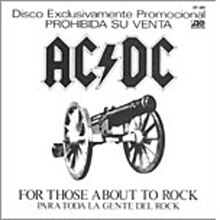For Those About to Rock (We Salute You)
This article needs additional citations for verification. (January 2020) |
| "For Those About to Rock (We Salute You)" | ||||
|---|---|---|---|---|
 | ||||
| Single by AC/DC | ||||
| from the album For Those About to Rock We Salute You | ||||
| B-side | "Let There Be Rock" (live) | |||
| Released | March 22, 1982 | |||
| Recorded | 1981 | |||
| Genre | Hard rock | |||
| Length | 5:43 | |||
| Label | Atlantic | |||
| Songwriter(s) | ||||
| Producer(s) | Robert John "Mutt" Lange | |||
| AC/DC singles chronology | ||||
| ||||
| Music video | ||||
| "For Those About to Rock (We Salute You)" on YouTube | ||||
"For Those About to Rock (We Salute You)" is a song by the Australian hard rock band AC/DC. The song was first released on AC/DC's eighth studio album For Those About to Rock We Salute You in 1981, and later as a single in 1982. The single's B-side contains an edited live version of "Let There Be Rock", recorded in Landover, Maryland, in late 1981. The video to "For Those About to Rock (We Salute You)" was filmed at that same concert.
The song was later included on AC/DC's first soundtrack album, Who Made Who, released in 1986 for the Stephen King film Maximum Overdrive.
Inspiration[]
The title and central lyric of the song are based on an ancient salute used by Roman prisoners to be executed in the Colosseum, "Ave, Caesar, morituri te salutant" ("Hail Caesar, those who are about to die salute you").
In February 2021, Speaking to Zane Lowe on Essentials Radio on Apple Music 1, Angus Young revealed that the inspiration behind the song "For Those About To Rock (We Salute You)" was British poet, novelist and classicist Robert Graves. Young explained to Lowe that the song's title was originally inspired by a twist on a line by Graves.
‘For Those About To Rock, it came out with Malcolm and myself, it was a combination,’ Young explained, revealing how he wrote "a little guitar thing" in the intro to the song, and his older brother Malcolm "had this little guitar chordal progression." ‘So the two of us worked on that and we came up with the verse idea of it,’ Young explained. ‘And the funny thing is, when we got to the chorus, we were going, "Okay, what are we going to sing on this?" And for me, I just thought, well, sometimes I go back [to] something I've read somewhere, and there was the writer Robert Graves, I believe his name was, I think he had a book out or a story he had put in one of the papers, because he did a lot of history stuff. And I had read it and it was, "For those about to die," and he went into a day in the Coliseum or somewhere in Rome at the time and the thing that the gladiators did. And I thought, "That might fit." So it was a case of, if I can come up with a way of singing something that can sing into it.’ ‘I think at first Malcolm thought, "Wait. What is he on?" And I'm going, "Well, for those about to ..." And I got it in, I got it all in, "For those about the rock." So that kicked off that.”[1]
Angus Young later said that the inspiration for the cannons came from a very different source than the song.[2] The band was cutting the first recordings of the song on the same day as Princess Diana of Great Britain's televised wedding. Angus recalled that "someone had the wedding on in the next room ... we were playing that part of the song when the cannons were going off and we paused a second and went 'hmmm ... that actually sounds pretty good.'"[citation needed] This coincidence also led to a cannon being featured on the cover of the album and single, as well as life-sized Napoleonic cannons becoming a regular stage prop at AC/DC concerts. The cannons fired in the song are mixed with exploding fireworks. However the actual takes were recorded later the next month as the mobile truck used to record the album (Mobile One) was being used to record Peter Gabriel's 4th eponymous album during the marriage of Charles and Diana.
Live performances[]
AC/DC have often used the song to close live concerts, such as Live at Donington and No Bull as well as on their live CD AC/DC Live. It is also the song that concludes the most recent tour, Rock or Bust.
Personnel[]
- Brian Johnson – lead vocals
- Angus Young – lead guitar
- Malcolm Young – rhythm guitar, backing vocals
- Cliff Williams – bass guitar, backing vocals
- Phil Rudd – drums
Charts[]
| Chart (1982) | Peak position |
|---|---|
| US Mainstream Rock (Billboard)[3] | 4 |
| UK Singles (OCC)[4] | 15 |
References[]
- ^ www.loudersound.com > Angus Young reveals that a British poet inspired one of AC/DC’s biggest anthems (AC/DC’s Angus Young reveals the unlikely inspiration behind one of the Aussie band’s most enduring anthems) by Classic Rock (23 February 2021)
- ^ AC/DC: High-Voltage Rock 'n' Roll: The Ultimate Illustrated History p.122. Retrieved 4 June 2011
- ^ "AC/DC Chart History (Mainstream Rock)". Billboard. Retrieved 10 March 2020.
- ^ "Official Singles Chart Top 100". Official Charts Company. Retrieved 10 March 2020.
External links[]
- 1982 singles
- AC/DC songs
- Atlantic Records singles
- Song recordings produced by Robert John "Mutt" Lange
- Songs written by Brian Johnson
- Songs written by Angus Young
- Songs written by Malcolm Young
- 1981 songs